Biography of King Oswald of Northumberland 604-641
Paternal Family Tree: Bernicia
King Oswald of Northumberland converted to Christianity.
King Oswald of Northumberland and Kyneburga Unknown Queen Northumbria were married. He the son of Æthelfrith King Northumbrians and Acha Queen Consort Northumbria.
Before 590 [his father] Æthelfrith King Northumbrians (age 18) and [his mother] Acha Queen Consort Northumbria were married. She by marriage Queen Consort Bernicia. She the daughter of Aella King Deira. He the son of Æthelric King Bernicia.
Around 592 Hussa of Bernicia died. [his father] Æthelfrith King Northumbrians (age 20) succeeded King Bernicia.
Around 604 King Oswald of Northumberland was born to Æthelfrith King Northumbrians (age 32) and Acha Queen Consort Northumbria.
Around 604 [his father] Æthelfrith King Northumbrians (age 32) succeeded King Deira. [his mother] Acha Queen Consort Northumbria by marriage Queen Consort Deira.
Anglo-Saxon Chronicle. 617. This year was [his father] Ethelfrith (age 45), king of the Northumbrians, slain by Redwald (age 47), king of the East-Angles; and [his uncle] Edwin (age 31), the son of Ella, having succeeded to the kingdom, subdued all Britain, except the men of Kent alone, and drove out the Ethelings, the sons of Ethelfrith (age 45), namely, [his brother] Enfrid (age 27), Oswald (age 13), [his brother] Oswy (age 5), [his brother] Oslac, [his brother] Oswood, [his brother] Oslaf, and [his brother] Offa.
In 617 Raedwald King East Anglia (age 47) and his son Raegenhere Wuffingas fought the Battle of the River Idle which took place at the River Idle Markham Moor Retford which forms the western border of the Isle of Lindsey [Map].
Raegenhere Wuffingas was killed.
[his father] Æthelfrith King Northumbrians (age 45) was killed. [his uncle] King Edwin of Northumbria (age 31) succeeded King Northumbria.
Bede. 634. AD. The place is called in the English tongue Hefenfelth [Map], or the Heavenly Field [Map]290, which name it undoubtedly received of old as a presage of what was afterwards to happen, denoting, that the heavenly trophy was to be erected, the heavenly victory begun, and heavenly miracles shown forth to this day. The place is near the wall in the north which the Romans formerly drew across the whole of Britain from sea to sea, to restrain the onslaught of the barbarous nations, as has been said before. Hither also the brothers of the church of Hagustald291, which is not far distant, long ago made it their custom to resort every year, on the day before that on which King Oswald (age 30) was afterwards slain, to keep vigils there for the health of his soul, and having sung many psalms of praise, to offer for him in the morning the sacrifice of the Holy Oblation. And since that good custom has spread, they have lately built a church there, which has attached additional sanctity and honour in the eyes of all men to that place [Map]292; and this with good reason; for it appears that there was no symbol of the Christian faith, no church, no altar erected throughout all the nation of the Bernicians, before that new leader in war, prompted by the zeal of his faith, set up this standard of the Cross as he was going to give battle to his barbarous enemy.
Note 290. For another instance of a name with an inner meaning, cf. II, 15. The site of the battle is probably seven or eight miles north of Hexham (v. next note), Oswald (age 30) having taken up his position on the northern side of the Roman wall between the Tyne and the Solway (i.e., the wall attributed to Hadrian, cf. I, 12, p. 25, note). According to tradition the battle was finally won at a place called Halydene (Hallington?), two miles to the east.
Note 291. Hexham [Map]. Wilfrid built a magnificent church there between the years 672-678 on land given by Ethelthryth, wife of Egfrid, king of Northumbria. It became the see of a bishop in 678 when the great northern diocese was subdivided by Theodore (v. IV, 12). Bede's own monastery of Wearmouth and Jarrow was in the diocese of Hexham. The bishopric became extinct in 821.
Note 292. The place is still called St. Oswald's [Map], and a little chapel probably marks the spot.
In 634 King Oswald of Northumberland (age 30) succeeded King Northumbria. Kyneburga Unknown Queen Northumbria by marriage Queen Northumbria.
Anglo-Saxon Chronicle. 634. This year Osric, whom Paulinus baptized, succeeded to the government of King of Deira. He was the son of Elfric, the uncle of [his uncle] Edwin. And to Bernicia succeeded [his brother] Eanfrith (age 44), son of [his father] Ethelfrith. This year also Bishop Birinus first preached baptism to the West-Saxons, under King Cynegils. The said Birinus went thither by the command of Pope Honorius; and he was bishop there to the end of his life. Oswald (age 30) also this year succeeded to the government of the King Northumbrians, and reigned nine winters. The ninth year was assigned to him on account of the heathenism in which those lived who reigned that one year betwixt him and Edwin.
Bede. 634. AD. How, among innumerable other miracles of healing wrought by the wood of the cross, which King Oswald, being ready to engage against the barbarians, erected, a certain man had his injured arm healed.
The place is shown to this day, and held in much veneration, where Oswald (age 30), being about to engage in this battle, erected the symbol of the Holy Cross, and knelt down and prayed to God that he would send help from Heaven to his worshippers in their sore need. Then, we are told, that the cross being made in haste, and the hole dug in which it was to be set up, the king himself, in the ardour of his faith, laid hold of it and held it upright with both his hands, till the earth was heaped up by the soldiers and it was fixed. Thereupon, uplifting his voice, he cried to his whole army, "Let us all kneel, and together beseech the true and living God Almighty in His mercy to defend us from the proud and cruel enemy; for He knows that we have undertaken a just war for the safety of our nation." All did as he had commanded, and accordingly advancing towards the enemy with the first dawn of day, they obtained the victory, as their faith deserved. In the place where they prayed very many miracles of healing are known to have been wrought, as a token and memorial of the king's faith; for even to this day, many are wont to cut off small splinters from the wood of the holy cross, and put them into water, which they give to sick men or cattle to drink, or they sprinkle them therewith, and these are presently restored to health.
In 634 King Oswald of Northumberland (age 30) won a decisive victory over the army of the Cadwallon ap Cadfan King Gwynedd at the Battle of Heavenfield which was fought at Heavenfield [Map] around six miles north of Hexham [Map].
Cadwallon ap Cadfan King Gwynedd was killed at a place Bede describes as Denisesburna which is possibly Rowley Water some eight miles south of the site of the battle.
Bede. 634. But soon after, the king of the Britons, Caedwalla285, the unrighteous instrument of rightful vengeance, slew them both. First, in the following summer, he put Osric to death; for, being rashly besieged by him in the municipal town [Map]286, he sallied out on a sudden with all his forces, took him by surprise, and destroyed him and all his army. Then, when he had occupied the provinces of the Northumbrians for a whole year287, not ruling them like a victorious king, but ravaging them like a furious tyrant, he at length put an end to [his brother] Eanfrid (age 44), in like manner, when he unadvisedly came to him with only twelve chosen soldiers, to sue for peace. To this day, that year is looked upon as ill-omened, and hateful to all good men; as well on account of the apostacy of the English kings, who had renounced the mysteries of the faith, as of the outrageous tyranny of the British king. Hence it has been generally agreed, in reckoning the dates of the kings, to abolish the memory of those faithless monarchs, and to assign that year to the reign of the following king, Oswald (age 30), a man beloved of God. This king, after the death of his brother Eanfrid (age 44)288, advanced with an army, small, indeed, in number, but strengthened with the faith of Christ; and the impious commander of the Britons, in spite of his vast forces, which he boasted nothing could withstand, was slain at a place called in the English tongue Denisesburna, that is, the brook of Denis289.
Note 285. Cf. II, 20, ad init.
Note 286. "In oppido municipio." Commentators are agreed that Bede means York. It was a Roman "Colonia," and is called a "municipium" by Aurelius Victor, though whether Bede attaches any definitely Roman meaning to the term seems doubtful. Ducange explains "municipium" as "castrum," "castellum muris cinctum."
Note 287. From the death of [his uncle] Edwin (October 12th, 633), for Oswald's (age 30) reign is reckoned as lasting nine years, including the "hateful year," and he was killed August 5th, 642. Cf. infra c. 9.
Note 288. i.e., probably before the end of 634.
Note 289. Not identified with any certainty, but probably the Rowley Water or a tributary of it. It cannot be, as has been suggested, the Devil's Water, which is clearly distinguished from it in a charter of the thirteenth century. Caedwalla must have fled southwards for eight or nine miles after the battle (cf. next note).
Anglo-Saxon Chronicle. 635. This year King Cynegils was baptized by Bishop Birinus at Dorchester [Map]; and Oswald (age 31), king of the Northumbrians, was his sponsor.
Bede. 635. AD. Of King Oswald's wonderful piety and religion.
King Oswald (age 31), with the English nation which he governed, being instructed by the teaching of this bishop, not only learned to hope for a heavenly kingdom unknown to his fathers, but also obtained of the one God, Who made heaven and earth, a greater earthly kingdom than any of his ancestors. In brief, he brought under his dominion all the nations and provinces of Britain, which are divided into four languages, to wit, those of the Britons, the Picts, the Scots, and the English.313 Though raised to that height of regal power, wonderful to relate, he was always humble, kind, and generous to the poor and to strangers.
Note 313. Cf. I, 1, p. 6, note 2.
Bede. 635. AD. How the same king Oswald, asking a bishop of the Scottish nation, had Aidan sent him, and granted him an episcopal see in the Isle of Lindisfarne.
The same Oswald (age 31), as soon as he ascended the throne, being desirous that all the nation under his rule should be endued with the grace of the Christian faith, whereof he had found happy experience in vanquishing the barbarians, sent to the elders of the Scots293, among whom himself and his followers, when in banishment, had received the sacrament of Baptism, desiring that they would send him a bishop, by whose instruction and ministry the English nation, which he governed, might learn the privileges and receive the Sacraments of the faith of our Lord. Nor were they slow in granting his request; for they sent him Bishop Aidan, a man of singular gentleness, piety, and moderation; having a zeal of God, but not fully according to knowledge; for he was wont to keep Easter Sunday according to the custom of his country, which we have before so often mentioned294, from the fourteenth to the twentieth of the moon; the northern province of the Scots, and all the nation of the Picts, at that time still celebrating Easter after that manner, and believing that in this observance they followed the writings of the holy and praiseworthy Father Anatolius295. Whether this be true, every instructed person can easily judge. But the Scots which dwelt in the South of Ireland had long since, by the admonition of the Bishop of the Apostolic see, learned to observe Easter according to the canonical custom296.
Note 293. i.e., Irish.
Note 294. Cf. II, 2, note on Paschal Controversy.
Note 295. Bishop of Laodicea, circ. 284 a.d. According to Eusebius, he was the first to arrange the cycle of nineteen years. The Canon quoted by the Celts in support of their observance of Easter is proved to be a forgery, probably of the seventh century and of British origin.
Note 296. Probably they adopted Catholic customs about 633, after the return of their delegates sent to consult the Roman Church on this question in 631.
Bede. 635. AD. On the arrival of the bishop, the king appointed him his episcopal see in the island of Lindisfarne297, as he desired. Which place, as the tide ebbs and flows, is twice a day enclosed by the waves of the sea like an island; and again, twice, when the beach is left dry, becomes contiguous with the land. The king also humbly and willingly in all things giving ear to his admonitions, industriously applied himself to build up and extend the Church of Christ in his kingdom; wherein, when the bishop, who was not perfectly skilled in the English tongue, preached the Gospel, it was a fair sight to see the king himself interpreting the Word of God to his ealdormen and thegns, for he had thoroughly learned the language of the Scots during his long banishment. From that time many came daily into Britain from the country of the Scots, and with great devotion preached the Word to those provinces of the English, over which King Oswald (age 31) reigned, and those among them that had received priest's orders298, administered the grace of Baptism to the believers. Churches were built in divers places; the people joyfully flocked together to hear the Word; lands and other property were given of the king's bounty to found monasteries; English children, as well as their elders, were instructed by their Scottish teachers in study and the observance of monastic discipline. For most of those who came to preach were monks. Bishop Aidan was himself a monk, having been sent out from the island called Hii299, whereof the monastery was for a long time the chief of almost all those of the northern Scots300, and all those of the Picts, and had the direction of their people. That island belongs to Britain, being divided from it by a small arm of the sea, but had been long since given by the Picts, who inhabit those parts of Britain, to the Scottish monks, because they had received the faith of Christ through their preaching.
Note 297. Cf. Preface, p. 4, note 3. The Celtic missionaries were generally attracted to remote sites, and this, the first mission station of the Celtic Church in Northumbria, was doubtless chosen for the resemblance of its physical features to Iona. The constitution was also modelled on that of Iona, with this difference, that it was an episcopal see as well as a monastery. It was included in the "province" of the Abbot of Iona. The Bishop and all the clergy were monks, and Aidan himself was Abbot as well as Bishop.
Note 298. "Sacerdotali," perhaps (but not necessarily here) = "episcopal," as often. There may have been a number of the Irish non-diocesan bishops in the mission.
Note 299. Iona, a name supposed to have arisen from a mistaken reading of Ioua, an adjectival form used by Adamnan (v. infra note 4), feminine, agreeing with insula, formed from the Irish name, I, Ii, Hii, etc. (the forms vary greatly). Then "Iona" was fancifully regarded as the Hebrew equivalent for Columba (= a dove), and this helped to preserve the name.
Note 300. i.e., Irish.
Bede. 635. AD. It is said, that when King Oswald (age 31) had asked a bishop of the Scots to administer the Word of faith to him and his nation, there was first sent to him another man of more harsh disposition312, who, after preaching for some time to the English and meeting with no success, not being gladly heard by the people, returned home, and in an assembly of the elders reported, that he had not been able to do any good by his teaching to the nation to whom he had been sent, because they were intractable men, and of a stubborn and barbarous disposition. They then, it is said, held a council and seriously debated what was to be done, being desirous that the nation should obtain the salvation it demanded, but grieving that they had not received the preacher sent to them. Then said Aidan, who was also present in the council, to the priest in question, "Methinks, brother, that you were more severe to your unlearned hearers than you ought to have been, and did not at first, conformably to the Apostolic rule, give them the milk of more easy doctrine, till, being by degrees nourished with the Word of God, they should be capable of receiving that which is more perfect and of performing the higher precepts of God." Having heard these words, all present turned their attention to him and began diligently to weigh what he had said, and they decided that he was worthy to be made a bishop, and that he was the man who ought to be sent to instruct the unbelieving and unlearned; since he was found to be endued preeminently with the grace of discretion, which is the mother of the virtues. So they ordained him and sent him forth to preach; and, as time went on, his other virtues became apparent, as well as that temperate discretion which had marked him at first.
Note 312. Hector Boethius gives his name as Corman.
On 05 Aug 641 (or 642 or 644 depending on the source) King Penda of Mercia Mercian and Welsh army defeated the Northumbrian army at the Battle of Maserfield. The battle is believed to have taken place at Oswestry, Shropshire. Northumbria was once again separated into two kingdoms.
King Oswald of Northumberland (age 37) was killed. His body was subsequently dismembered with his head and arms mounted on poles. His brother [his brother] King Oswiu of Northumbria (age 29) succeeded King Bernicia. Rhiainfellt Rheged Queen Consort Bernicia by marriage Queen Consort Bernicia.
Osric King Deira was killed. His son King Oswine of Deira succeeded King Deira.
Eowa King Mercia was killed (probably).
Anglo-Saxon Chronicle. 642. This year Oswald, king of the Northumbrians, was slain by Penda, king of the Southumbrians, at Mirfield, on the fifth day of August; and his body was buried at Bardney. His holiness and miracles were afterwards displayed on manifold occasions throughout this island; and his hands remain still uncorrupted at Barnburgh. The same year in which Oswald was slain, [his brother] Oswy (age 30) his brother succeeded to the government of the Northumbrians, and reigned two less than thirty years.
After 1641. Around 1.5 km north of Winwick Church is St Oswald's Well, Hermitage Green supposedly at the place where King Oswald of Northumberland during the Battle of Maserfield. The well chamber is square and measures 0.7m across and is about 1.9m deep with three steps on the south side leading down to the water. A large stone slab has been placed over the aperture, covering half of the opening and protecting the remains from cattle or human access.
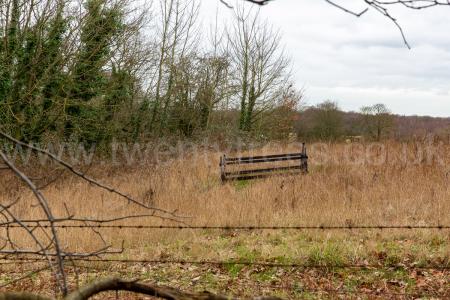
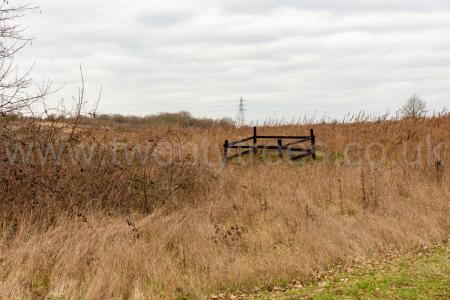
Before 05 Aug 642 [his son] Æthelwald King Deira was born to King Oswald of Northumberland.
St Oswald's Church Heavenfield [Map] is believed to mark the location where King Oswald of Northumberland raised his standard at the Battle of Heavenfield.
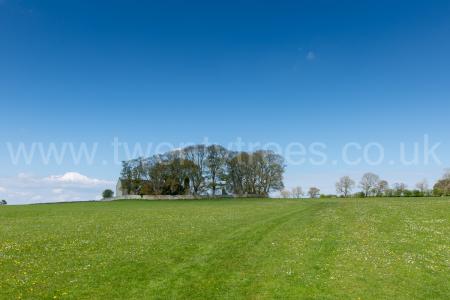
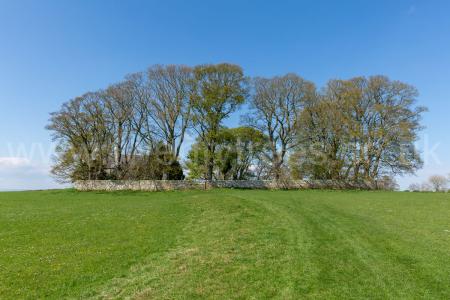
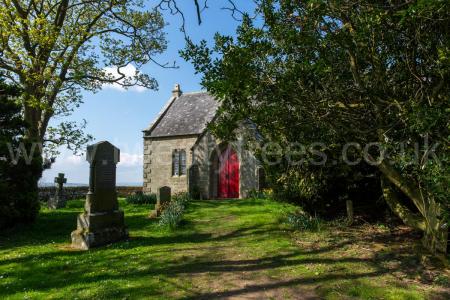
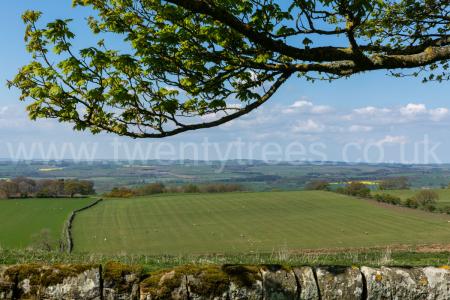
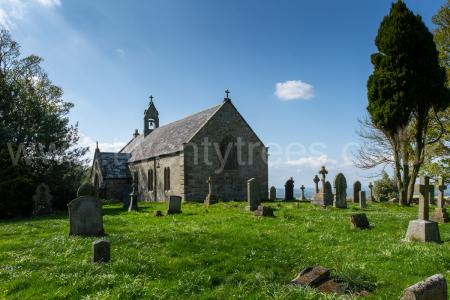
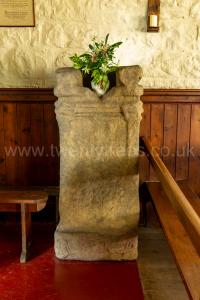
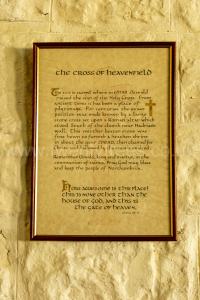 The Cross of Heavenfield. Around 200AD. Formerly set upon a Roman altar.
The Cross of Heavenfield. Around 200AD. Formerly set upon a Roman altar.
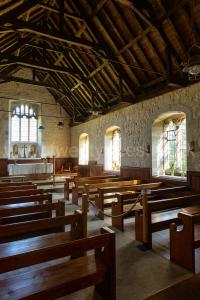
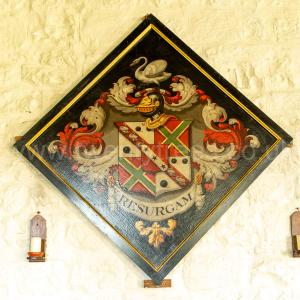
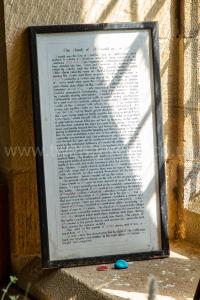
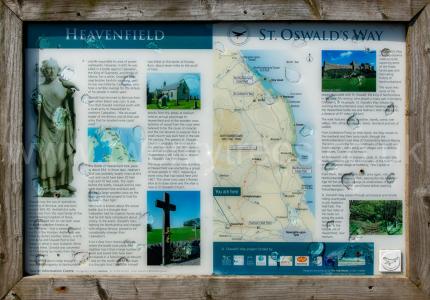
Kings Bernicia: Grand Son of Æthelric King Bernicia
Kings Deira: Grand Son of Aella King Deira
Great x 2 Grandfather: Eoppa Bernicia
Great x 1 Grandfather: Ida King Bernicia
GrandFather: Æthelric King Bernicia
Father: Æthelfrith King Northumbrians
Great x 1 Grandfather: Yffe Deira
GrandFather: Aella King Deira
Mother: Acha Queen Consort Northumbria